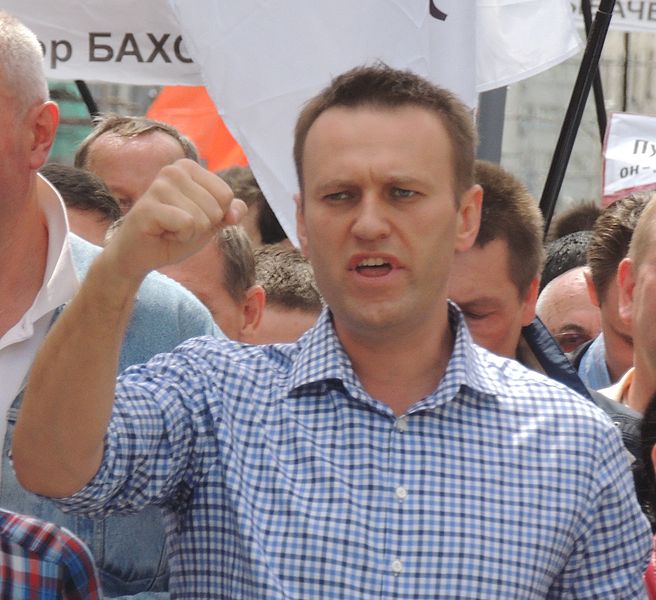The Tymoshenko Effect?
On Thursday July 18th 2013, the most widely recognised anti-Putin opposition figure in Russia, Alexei Navalny, was found guilty of embezzling and stealing from a timber company. He was sentenced to five years in prison.
July 21, 2013 -
Adam Reichardt
-
Articles and Commentary

656px-Alexey_Navalny_at_Moscow_rally_2013-06-12_3.jpg
Within less than an hour of the sentencing being read in Kirov, supporters of Navalny began organising mass protests across Russia. Through Facebook, Twitter, Vkontakte and text messaging, Navalny’s “team” instantaneously mobilised his supporters to come out in force and protest the verdict and sentencing.
By chance, I was in central Moscow during this time and went down to Manezhnaya Square to see the reaction for myself. Thousands (probably around 4,000 or 5,000) of people gathered to show their opposition to the sentencing of Navalny. All kinds of people could be seen: young, old, well-off, less well-off; and they all had one message: they were not happy with the results of the trial. Cheers were heard of “Navalny” and “Freedom”. For the most part, the protests concluded without incident late during the night, although droves of police and OMON forces were on hand in case of any sign of aggression. In fact, some protesters were even detained, but surprisingly the “unsanctioned” protest was allowed to carry on for some time.
But the question remains: is this the reaction the regime was hoping for? Did they not expect such a reaction? It appears that they underestimated what would happen, so much so that the prosecutor in Kirov quickly asked for Navalny to remain free until his appeal could be heard. The fact that Navalny was released on Friday is one sign that the authorities don’t want the opposition movement to regain its strength. However, they may well have realised this mistake too late.
By imprisoning Navalny the authorities in Russia risk the “Tymoshenko effect” – creating a political prisoner who becomes a symbol and hero for the opposition (as well as the West) to rally around; someone who can represent all that is bad about the regime (no matter if he/she is guilty).
Mikhail Khodorkovsky has somewhat played this imprisoned anti-Putin “democratic” figure, although he wasn’t openly active in politics before his incarceration and in fact can be easily depicted as more of a rival oligarch than politician. Navalny, on the other hand, has already found himself in the centre of the opposition movement (which he helped to build), playing a prominent leadership role. His charismatic speaking style and ability for online mobilising have also helped to shape his image. And when the embezzlement case was reopened against Navalny, no one had any illusions that there was nothing but political motivation behind his prosecution.
It is true that even before the trial Navalny was the primary spokesperson of the loosely organised opposition/protest movement. But before Thursday, that movement was beginning to show signs of fatigue. The masses were no longer coming out for every protest and it appeared that there weren’t many clear, coordinated policy solutions emerging from this movement. Navalny’s political ambitions were not deterred, however, and earlier this summer he declared that he would run for mayor of Moscow in this September’s special election.
Navalny’s support among Muscovites, however, did not appear as strong as we are sometimes led to believe. The Levada Center recently published opinion poll data showing that Navalny’s support is depressingly low. In a poll conducted between July 4th-8th 2013, only four per cent declared support for Alexei Navalny as mayor. This is opposed to the 34 per cent who declared support for the current mayor, Sergei Sobyanin. It will be interesting to see how the trial’s results, which have shone the spotlight back on Navalny, will affect the public opinion polls in the coming month and a half, and how the campaign for mayor, should Navalny be allowed to continue to run, will unfold.
For the moment, Navalny remains free. Perhaps the authorities finally realised, albeit a little too late, that losing an election could discredit his status much more than a politically-motivated trial. Nevertheless, there is clearly some fight left in this movement. The new laws against “unsanctioned protests” didn’t stop the people from coming out onto the streets on Thursday.
Putting Navalny in prison would most likely reinvigorate the movement even more. Having a figure with near-rock star status in prison will be a constant reminder and even a symbol of the regime’s fear of the opposition and its selective justice for both the people of Russia and the West; just as former prime minister Yulia Tymoshenko has been for Ukraine. His release from custody on Friday, pending his appeal, is already a sign that the authorities don’t want this pot to boil over once again.
Adam Reichardt is editor-in-chief of New Eastern Europe. You can follow him on Twitter @areichardt.
See Adam Reichardt’s photos of the recent Navalny protests in Moscow below:







































